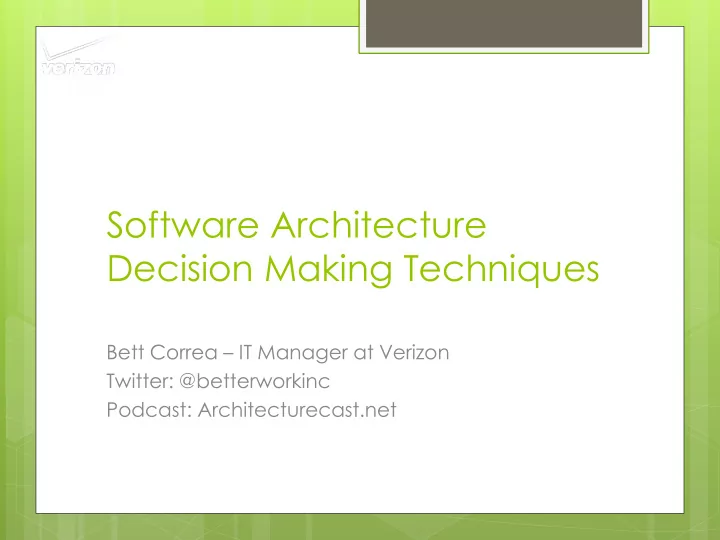

Software Architecture Decision Making Techniques Bett Correa – IT Manager at Verizon Twitter: @betterworkinc Podcast: Architecturecast.net
Overview Context Philosophies Actions Psychologies Summary
Course Objectives Goal of course: Familiarize yourself with philosophies, actions, and psychologies of decision making techniques. After taking the course participants will be able to Identify several philosophies of decision making Identify several actions to make better decisions Identify several psychologies you need to manage to make better decisions
Definition Decision-making Verb Decision-making is the study of identifying and choosing alternatives based on the values and preferences of the decision maker synonyms: Execution, cognitive process
Statistics According to studies, the average human makes about 612 decisions a day. This equals to 4,900 decisions in a week and 254,800 in a year SOURCE
Why you need to take this course Why should I bother with this? “Building software falls into an interesting case of problems known as wicked problems". This means basically that there are many possible solutions and that no solution is really "right" or "wrong" only "better" or "worse" given your current understanding of the problem. Further each problem is essentially unique, there isn't an explicit stopping rule, and as the designer you will be held liable for consequences of your solution .“ Michael Keeling – Architect at IBM
Context What context are we dealing with today? Enterprise Architecture Decisions System Level Architecture Decisions Interface level Decisions between systems
Design Knowledge
Philosophies
Philosophy Extreme programming: Design your system for the requirements we have NOW.
Philosophy Systems evolve and each version builds on the previous
Philosophy Agile/Lean: make big hard decisions as late as possible
Philosophy Conclusion: make decisions that reduce the cost of making change later
Actions
Actions: Reduce the Unknown Find out what is important: Run a quality attributes workshop with all stakeholders including users System SMEs, product owners, QA, architects
Actions: Reduce the Unknown Uncover hidden requirements by using contextual design. Contextual Design engages the people doing the work and studies their intents and problems to ensure the software system developed is more in tune with the user's actual needs. It provides a powerful tool for software engineers to use as input into their requirements and architecture
Actions: Get the Evidence Don’t rely on hearsay, go to the source If the right people are not on in the meeting, end the meeting
Actions: Find a Solution Write out the pros and cons for the customer for each solution and review with stakeholders.
Actions: Find a Solution Do a Pre-Mortem on your possible solutions Imagine the project is over and talk about what went wrong using each solution
Actions: Find a Solution Talk your solutions over with experts from other areas
Actions: Reduce the Unknown Prototype and show it to the users!
Actions: Reduce the Unknown Conclusion from Actions: identify issues early and change direction quickly
Psychologies
Psychology Realize tha t most blocks to decisions aren’t technical: They are political Political means Psychology
Character Trustworthy Helpful Reciprocation
Know thy Audience
Know your Objective
Connect the two
Presentation Explain the problem completely Answer any questions to ensure they understand the real problem Only then once they understand the problem, give them the solution.
Conversation Models So What’s Your Point?
Summary / Review Decision Making Toolkit Philosophy Actions Psychology
Resources General Decision Making Resource: http://hbr.org/web/management-tip/tips-on-decision-making Agile Resources: Lean Startup – Eric Ries http://johnnycoder.com/blog/2010/06/18/introduction-to-lean-software-development-and- kanban-systems-defer-commitment-and-decide-as-late-as-possible/ Design Strategies: http://www.neverletdown.net/2010/08/choosing-a-software-design- strategy.html Quality Attributes Workshop resource: SATURN 2014 Presentation http://resources.sei.cmu.edu/asset_files/Presentation/2014_017_101_89563.pdf Politics resource: So What’s your Point? by James C. Wetherbe and Bond Wetherbe Speed of Trust by Stephen M.R. Covey Secrets of Closing the Sale by Zig Zigler Just in Time Architecture by George Fairbanks
Questions? Bett Correa- Manager at Verizon • bettworld@gmail.com • @betterworkINC • Blog: Betterworkinc.com • Author of • Improv Your Novel in 30 Days • You Can Be a Software Architect • And Engineer Your Perfect Child • And Step by Step: Write, Self-Publish, and • Market Your Book Podcast: Architecturecast.net •
Recommend
More recommend